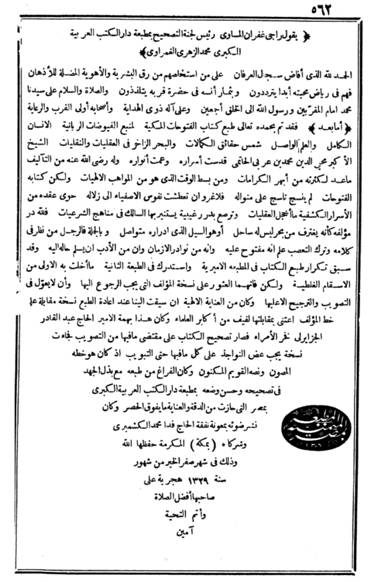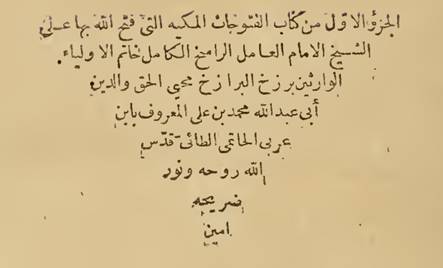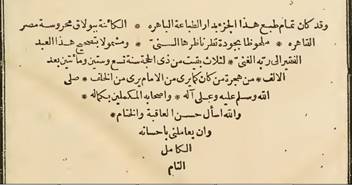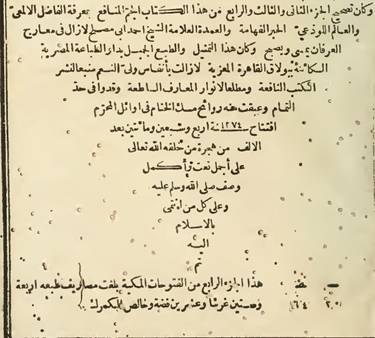Editions of the Meccan Revelations
Summary of the first introductory volume of the investigation
Bulaq's first edition [photocopy]
Bulaq Press printed the Book of Meccan Revelations for the first time over a period of five years starting from The year 1269 AH / 1852 AD until the year 1274 AH / 1857 AD, under the supervision of the proofreader Sheikh Ahmed Abu The reformer of Al-Abyari and the proofreader, Muhammad Qatta, son of Sheikh Abdul Rahman Al-Adawi, and the cost of printing it About sixty-four piasters:
This edition was in four volumes: the first volume was 800 pages, and the second volume It was 772 pages, the third volume was 628 pages, and the fourth volume was 611 pages of text. The main article is excluding the index and conclusion that were added to the edition, and excluding the blank pages. And it has At the end of the fourth volume, the editor Muhammad Qatta al-Adawi added a summary of the biography of Sheikh Muhyiddin A summary from Nafah al-Tayeb’s book.
Bulaq's second edition [photocopy]
After that, Bulaq Press reprinted the Book of Meccan Revelations in the year 1293 AH / 1876 AD. Corrected by Sheikh Muhammad Qatta Al-Adawi, but both of these editions had many errors due to... Their reliance on late manuscripts is incorrect due to the lack of copies of the original manuscripts. It is clear from During the arrangement of the parts of the book, it is based on the first edition issued by the Sheikh The largest in Damascus in the year 629 AH.
Bulaq third edition - Maymaniya edition [Illustrated copy]
The Great Arab Book House was established in Cairo by Ahmad al-Babi al-Halabi in the year 1859 AD in the name of the Al-Maymaniyah Printing Press, which was located opposite Al-Azhar Mosque, printing Al-Futuhat. Mecca in the year 1329 AH / 1911 AD at the expense of Hajj Fida Muhammad Al-Kashmiri and his partners in Mecca. In it, the errors that occurred in the two editions of Bulaq were corrected, and the head of the correction committee, Sheikh Muhammad, mentioned it Al-Zuhri Al-Ghamrawi said that it was too late for my Bulaq edition to look at the author’s copy, and that it was a matter of care It was divine that a copy was sent to them, which was compared to the Konya copy, which was in the author’s handwriting. He compared it A group of scholars by order of Prince Abdul Qadir Al-Jazairi, may God Almighty have mercy on him, and you know this The edition is called the Cairo Edition.
As is the case with the Bulaq edition, the Cairo edition contains four volumes. With a difference in the number of pages: the first volume contains 763 pages, and the second volume contains 693 pages, the third volume contains 568 pages, and the fourth volume contains 554 pages. For the main text, excluding the index and conclusion that were added to the edition, and excluding the blank pages. The conclusion of the corrector Muhammad Qatta Al-Adawi, which he placed at the end of the fourth volume of the book, was also added Bulaq edition, which contains a summary of the biography of Sheikh Muhyiddin, summarized from the book Nafah The good one. Then Sheikh Muhammad Al-Zuhri Al-Ghamrawi, Chairman of the Correction Committee at Dar Al-Kutub Press, added Greater Arabic A brief conclusion at the end of the fourth volume mentions the occasion of this edition Its history:
 |
| Conclusion of Sheikh Muhammad Al-Zuhri Al-Ghamrawi, Chairman of the Correction Committee The Great Arab Book House Press |
It is clear from this conclusion that those supervising the printing of the book did not review the manuscript themselves Konya, in the handwriting of Sheikh Muhyi al-Din, but on a corresponding and corrected copy, which was arranged He made a lot of mistakes, such as not highlighting many of the book's internal titles in the image Which was highlighted by Sheikh Al-Akbar in his manuscript, so the text came out in long passages that were difficult to follow And find out its beginning and end.
In this investigation, Othman Yahya made a strenuous effort in controlling the text and developing an introduction to each book He explained some ambiguous sentences and created subtitles and indexes, but his work was not devoid of errors Errors (see Abdul Aziz Al-Mansoub’s notes in the Maymaniya edition below). This was issued The fourteen books published by the Egyptian General Book Authority with different dates, between the year 1972 AD and the year 1992 AD, and the submission was written by the President of the Arabic Language Academy in Cairo, Dr. Ibrahim Madkour (1902 AD - 1996 AD).
Electronic copies [Download photocopies]
In recent decades, many publishing houses have republished the Cairo edition, via Depicted with their original features hidden, these prints have been in circulation for a long time. And with The advent of the Internet and electronic publishing These editions were circulated over the Internet, via Initially photographed, then converted to text and reformatted with different images.
Initially a text version appeared on the Alwaraq website (alwaraq.net), and it contained a lot of... Errors generated by automatic character recognition (OCR) programs, as well It did not take into account the page numbering according to the published editions. Then another text version appeared on the website (onetradition.org) It is a good version that is fully compatible with the Cairo edition. Then it spread Many electronic copies, both text and images, on various websites.
Recent editions [Download photocopies]
The Islamic Heritage Revival House was established in Beirut in 1997 AD, as well as the Scientific Books House In Beirut in 1999 AD, issuing a modern edition of the Meccan Revelations, with modern formatting and directing, with Graduating Qur’anic verses and Prophetic hadiths, shaping them, forming poetic verses, and some Other words. These editions do not include any new study of the book’s manuscripts, however It can be considered the clearest version that has appeared to date, and it is a modern re-production of the Cairo edition.
The Ihya al-Turath edition was published in four parts, while the Dar al-Kutub edition was published in eight Volumes, in addition to the indexes volume, because each volume of the original Cairo edition includes Two parts, but the page numbering is different from the page numbering of the Cairo edition.
Yemeni Edition [Download photocopies]
This edition was issued a few years ago by the Ministry of Culture of the Republic of Yemen on the occasion of Celebrating the city of Tarim as the capital of Islamic culture in 1431 AH / 2010 AD, and achieved it. Professor Abdul Aziz Sultan Al-Mansoub, based on the Konya manuscript and the library manuscript Sulaymaniyah in addition to the Cairo edition mentioned above. This edition includes twelve Volumes containing indexes of Qur’anic verses and Prophetic hadiths with their graduations, and indexes of poetry. Sheikh Muhyiddin and the poems he cited, an index of Sufi terms, and an index of names Notable figures, an index of place names, an index of the books mentioned in each book, and an index of sects And groups.
The investigator says in the introduction that Dr. Othman Yahya made many mistakes in his investigation. Such as: “The omission of entire phrases and many words from the verified version, and the appearance of added words from others Pointing out this...in addition to the frequent occurrence of errors in proving the attribution of a specific text to a copy specific, while its origin is in the other version...” In addition to the fact that he was not very successful in Use punctuation marks. He also tried to create a special relationship between the Grand Sheikh’s bars And the culture of the Ismaili school, to the extent that he seemed to be a student of the sheikhs of this school.
The truth is that many of these observations may be true, but the study The analysis of the text carried out by Othman Yahya had great benefits for a great purpose The importance of revealing many unclear words or phrases, and dividing paragraphs He gave them titles indicating their content, and added many explanatory footnotes By explaining some ambiguous sentences and solving many problems in the text. We wished that Professor Abdul Aziz Al-Mansoub completed such a great work that prevented the death of Othman Yahya To complete it.
It seems that Professor Abdel Aziz initially tried to follow this approach, but he soon... He abandoned it in later books, and may have quoted it often from the investigation of Uthman Yahya The same, to the point that he made the same mistakes that Othman Yahya made, such as adding comments It restricts the text and may direct it in a completely wrong direction.
For example: On page 74 of the first part of the investigation by Professor Abdul Aziz Najd The phrase: “The facts are now in judgment (=in the eye), as they were in science.” And here We find that the addition (=in the eye) is transferred exactly as it was mentioned in the investigation of Othman Yahya (Al-Safar The first, page 54), which is not successful at all; This is a mixture of terms The subtleties in Sheikh Muhyi al-Din’s words are very dangerous, and the two words here are: “al-hukm” and “eye”. Two terms with completely different meanings. Sheikh Muhyiddin says after a few pages of: This text: “Objects do not change and facts do not change.” Existent things have objects. Facts have rulings, and we do not say that facts have objects. As for our saying, for example: “The truth "The word itself" is not a term here, and it only means: "the truth itself"
In some places we also find Professor Abdul Aziz (on page 125 of the first volume) Dr. Othman (on page 141 of the first book) divides one paragraph into two parts, Erroneously and in the same way, they begin the new paragraph with the phrase, “And I am the first to advise himself in that. ..." Which indicates that the speaker here is Sheikh Muhyiddin. The truth is that this... The phrase is a conjunction of a sentence that began on the previous page of the manuscript (Konya): “But A rational, eloquent, and sincere person does not throw it, but says, “This is permissible in my opinion...” That is, the wise and intelligent person, and what is meant is the reader, must say to himself: “This is permissible in my opinion.” ...And I am the first to advise himself in that.”
In a third example that draws attention, Abd al-Aziz al-Mansoub made a mistake (vol. 1: p. 150), which appears to be He followed Uthman Yahya’s edition of Uthman Yahya (The First Book: p. 191), who in turn made a mistake in favoring An incorrect statement in the Cairo edition (vol. 1: p. 42), and we do not know whether the error was on the part of the committee that was involved It is based on the Bulaq edition or from the copyist of the manuscript they quoted, as the same error occurred in the edition Bulaq also (vol. 1: p. 45), which is the original on which the Cairo edition was based, and this error was not It is corrected in its copy by Sheikh Muhammad Effendi bin Mustafa Tantawi, who was entrusted by Emir Abdul Qadir Al-Jazairi, along with Sheikh Muhammad al-Tayeb al-Mubarak al-Jazairi, carried out the correction and contrasting of the edition Bulaq with the Konya manuscript, as mentioned above.
Everyone made a mistake in deleting the negative tool from the phrase: “It does not contradict the validity of the slave’s action.” So they wrote it: “Algebra is not valid according to the investigator because it contradicts the validity of the act of the slave,” contrary to what it is In the Konya manuscript (First Book: p. 72), as well as in the Sulaymaniyah manuscript, and all manuscripts The other ones that I examined, giving preference to their opinion over the precise words of the Sheikh, because the sentence It becomes simple and clear in this way: “Algebra is not valid for the investigator because it contradicts the validity of the act “For the slave,” which means that reparation is not valid because if it were valid, the act would not be attributed to the slave. Which may mean that he will not be held accountable for his actions.
But what is correct is what Sheikh Muhyiddin wrote: “Algebra is not valid according to the investigator because it does not It contradicts the validity of the slave’s action.” This means: reparation is not valid because if it were valid, the action would be valid For the servant, because compulsion necessarily means the presence of abstinence, and it is a verb, so he said, may God be pleased with him Then he said: An inanimate object is not obligatory because no action can be imagined from it. The result is that Algebra is not valid for investigators because “it is not conceivable that an action is possible and does not have a mind Verified,” with traces of it appearing, as the Sheikh explained in the sentence that follows. If algebra is correct The action is valid for the slave, because the definition of algebra is: “Assuming the possible to be based on the action with the presence of denial of Possible", and abaya is an action, so coercion leads to attributing the action to the servant in a way that makes it his A will that contradicts the divine will, that is, as if God Almighty is forcing him to do so Something he does not want, and this is not permissible. This meaning is confirmed by the Sheikh’s statement on the same page (Or the next page, depending on the differences in versions): “If the verb “possibly” is correct, then “that” is correct He is capable, and if He has no action, He has no power...”
It is not permissible to change the text written by the author as long as there is a possibility that it is correct, whatever that may be The possibility is remote, and it is clear here; Rather, how is it possible for this sentence to pass on Sheikh Mohi? Religion in the first version and in the second version, and it passes during reviews and hearings on it And on his students, it is a mistake, but rather it is intended in this correct form, and many of the Sheikh’s statements are not Its meaning is clear at first glance.
In any case, such a huge work is difficult to be free of errors, and there is a constant necessity To review and re-check several times, we will point out some of these errors within Asfar Book whenever appropriate.
=================
[1] (Hilyat Al-Bishr) 1/335, (Amir Abdul Qadir Al-Alam Al-Mujahid) p. 28.
[2] Baqbaq, what is known and proven is that Sheikh Abdul Majeed Al-Khani (named after Khan Shaykhun) And his father (Sheikh Muhammad) were famous for their specialization in philosophical Sufism, and for their passion for Ibn Arabi. Therefore, when the scholar Jamal al-Din al-Qasimi translated it for his sheikhs and the people of his time.






